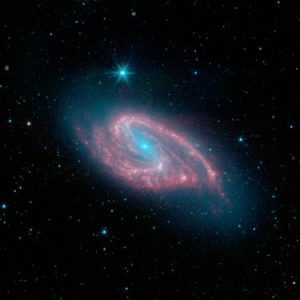Messier 66: Difference between revisions
No edit summary |
|||
| (2 intermediate revisions by the same user not shown) | |||
| Line 1: | Line 1: | ||
Messier 66 (also known as NGC 3627) is an intermediate spiral galaxy about 36 million light-years away in the constellation [[Leo]]. It was discovered by Charles Messier in 1780. M66 is about 95 thousand light-years across with striking dust lanes and bright star clusters along sweeping spiral arms. M66 is part of the famous Leo Triplet, a | [[File:375px-Sig05-016.jpg|thumb|Messier 66]] | ||
Messier 66 (also known as NGC 3627) is an intermediate spiral galaxy about 36 million light-years away in the constellation [[Leo]]. It was discovered by Charles Messier in 1780. M66 is about 95 thousand light-years across with striking dust lanes and bright star clusters along sweeping spiral arms. M66 is part of the famous Leo Triplet, a small group of galaxies that also includes M65 and NGC 3628. | |||
Gravitational interaction from its past encounter with neighboring NGC 3628 has resulted in: | Gravitational interaction from its past encounter with neighboring NGC 3628 has resulted in: | ||
| Line 5: | Line 6: | ||
An extremely high central mass concentration;A high molecular to atomic mass ratio;A resolved noncorotating clump of H I material apparently removed from one of the spiral arms. | An extremely high central mass concentration;A high molecular to atomic mass ratio;A resolved noncorotating clump of H I material apparently removed from one of the spiral arms. | ||
This third result shows up visually as an extremely prominent and unusual spiral arm and dust lane structures as originally noted in the Atlas of Peculiar Galaxies.<ref>[http://en.wikipedia.org/wiki/Messier_66 Messier 66]</ref> | This third result shows up visually as an extremely prominent and unusual spiral arm and dust lane structures as originally noted in the Atlas of Peculiar Galaxies.<ref>[http://en.wikipedia.org/wiki/Messier_66 Messier 66]</ref> | ||
==HGS Session References== | ==HGS Session References== | ||
HGS Sessions - Clearing [[Sexual Misery, Breeder Programs]] - 3/31/2015 <ref>HGS Session</ref>HGS Sessions - Clearing [[Penn State, Happy Valley]] - 4/24/2015 <ref> HGS Session</ref> | |||
HGS Sessions - Clearing [[Sexual Misery, Breeder Programs]] - 3/31/2015 <ref>HGS Session</ref> | |||
==References== | ==References== | ||
Latest revision as of 21:29, 24 April 2015
Messier 66 (also known as NGC 3627) is an intermediate spiral galaxy about 36 million light-years away in the constellation Leo. It was discovered by Charles Messier in 1780. M66 is about 95 thousand light-years across with striking dust lanes and bright star clusters along sweeping spiral arms. M66 is part of the famous Leo Triplet, a small group of galaxies that also includes M65 and NGC 3628.
Gravitational interaction from its past encounter with neighboring NGC 3628 has resulted in:
An extremely high central mass concentration;A high molecular to atomic mass ratio;A resolved noncorotating clump of H I material apparently removed from one of the spiral arms. This third result shows up visually as an extremely prominent and unusual spiral arm and dust lane structures as originally noted in the Atlas of Peculiar Galaxies.[1]
HGS Session References
HGS Sessions - Clearing Sexual Misery, Breeder Programs - 3/31/2015 [2]HGS Sessions - Clearing Penn State, Happy Valley - 4/24/2015 [3]
References
- ↑ Messier 66
- ↑ HGS Session
- ↑ HGS Session
Found in HGS Manual on Page 108 Found in HGS Manual on Page 115


